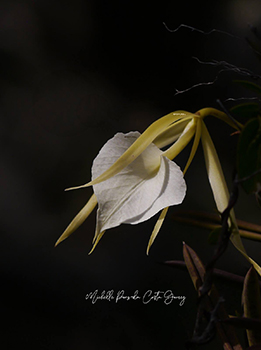This post is also available in: Dutch (below)

The best-known orchid that naturally occurs on the islands of Aruba, Bonaire and Curaçao is perhaps the Brassavola nodosa, also known as the ‘Lady of the Night’. It is also the most common orchid on the island of Curaçao, slightly scarcer on Bonaire and very rare in the wild on Aruba. The plant belongs to the group of so-called epiphytes. These are plants that grow on top of other plants without harming their host. Tree bromeliads (tillandsias) and other plant species also exhibit this ‘behaviour’. They do this because they do not have a long stem themselves with which they can optimally benefit from the sunlight with their leaves. That is why they use the length of trees or cacti to grow as high as possible, towards the sunlight. The host is usually not affected by this, as mentioned. Except when so many epiphytes grow on a branch that it breaks off due to the weight. They are therefore not parasites, plants that tap water or nutrients from their host with their roots.
In November, the white orchids start to bloom profusely and this blooming continues until about March. The flowers smell very strongly at night and attract moths and probably bats. The species is the basis of many cultivated varieties of orchids in the plant trade and is therefore one world-famous species. Due to the wild urge to collect, the plants in the wild have decreased considerably in numbers.
English name: Lady of the Night orchid
Papiamentu/Papiamento name: Orkidia blanku (Curaçao, Bonaire) Orkidia di mondi (Aruba)
Scientific name: Brassavola nodosa
Family: Orchidaceae (orchids)
Occurrence (ABC islands): Aruba, Bonaire and Curaçao

De witte orchidee of Brassavola nodosa

De bekendste orchidee die van nature voorkomt op de eilanden Aruba, Bonaire en Curaçao is misschien wel de Brassavola nodosa ook wel bekend als De ‘Lady of the Night’, Het is ook de meest algemeen voorkomende orchidee op het eiland Curaçao, een stuk schaarser op Bonaire en bijna uitgestorven in het wild op Aruba. De plant behoort tot de groep van de de zogenaamde epifieten. Dit zijn planten die bovenop andere planten groeien zonder hun gastheer schade te berokkenen. Ook boombromelia’s (tllandsia’s) en andere plantensoorten vertonen dit ‘gedrag’. Dit doen ze omdat ze zelf geen lange stengel hebben waarmee ze met hun bladeren optimaal van het zonlicht kunnen profiteren. Daarom maken ze gebruikt van de lengte van bomen of cactussen om zo hoog mogelijk, richting het zonlicht, te groeien. De gastheer ondervindt hier meestal, zoals gezegd geen last van. Behalve als er zoveel epifyten op een tak groeien dat deze door het gewicht afbreekt. Het zijn dus geen parasieten, planten die met hun wortels water of voedingsstoffen aftappen van hun gastheer.
In November beginnen de witte orchideeën uitbundig te bloeien en dat bloeien gaat door tot ongeveer maart. De bloemen ruiken ’s nachts heel sterk en trekken dan motten en waarschijnlijk ook vleermuizen aan. De soort staat aan de basis van heel veel kweekvariaties van orchideeën in de plantenhandel en is daarmee één wereldbekende soort. Door de woeste verzameldrang van mensen zijn de planten in het wild behoorlijk afgenomen in aantallen.
Nederlandse naam: Witte orchidee
Papiamentse naam: Orkidia blanku (Curaçao, Bonaire) Orkidia di mondi (Aruba)
Wetenschappelijke naam: Brassavola nodosa
Familie: Orchidaceae (orchideeën)
Voorkomen (ABC eilanden): Aruba, Bonaire en Curaçao